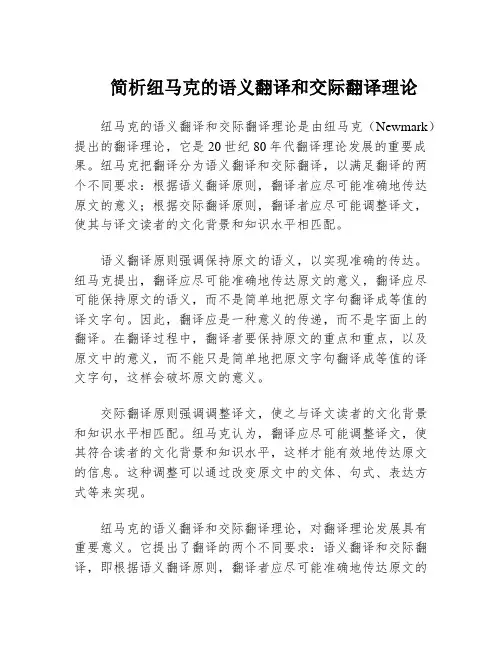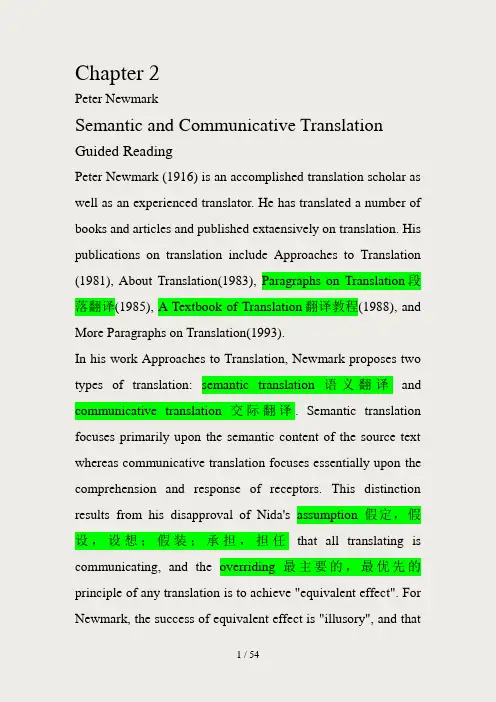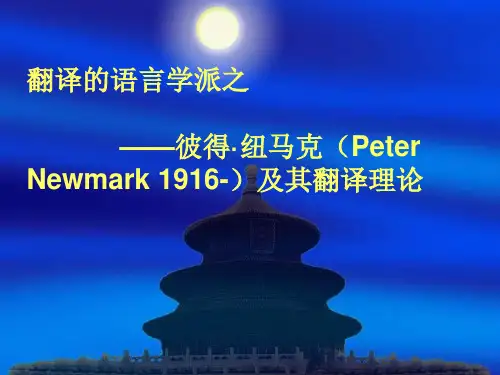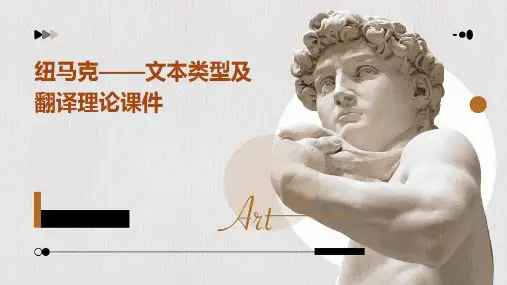纽马克的翻译理论共26页
- 格式:ppt
- 大小:2.03 MB
- 文档页数:26

简析纽马克的语义翻译和交际翻译理论纽马克的语义翻译和交际翻译理论是由纽马克(Newmark)提出的翻译理论,它是20世纪80年代翻译理论发展的重要成果。
纽马克把翻译分为语义翻译和交际翻译,以满足翻译的两个不同要求:根据语义翻译原则,翻译者应尽可能准确地传达原文的意义;根据交际翻译原则,翻译者应尽可能调整译文,使其与译文读者的文化背景和知识水平相匹配。
语义翻译原则强调保持原文的语义,以实现准确的传达。
纽马克提出,翻译应尽可能准确地传达原文的意义,翻译应尽可能保持原文的语义,而不是简单地把原文字句翻译成等值的译文字句。
因此,翻译应是一种意义的传递,而不是字面上的翻译。
在翻译过程中,翻译者要保持原文的重点和重点,以及原文中的意义,而不能只是简单地把原文字句翻译成等值的译文字句,这样会破坏原文的意义。
交际翻译原则强调调整译文,使之与译文读者的文化背景和知识水平相匹配。
纽马克认为,翻译应尽可能调整译文,使其符合读者的文化背景和知识水平,这样才能有效地传达原文的信息。
这种调整可以通过改变原文中的文体、句式、表达方式等来实现。
纽马克的语义翻译和交际翻译理论,对翻译理论发展具有重要意义。
它提出了翻译的两个不同要求:语义翻译和交际翻译,即根据语义翻译原则,翻译者应尽可能准确地传达原文的意义;根据交际翻译原则,翻译者应尽可能调整译文,使其与译文读者的文化背景和知识水平相匹配。
它的出现,被认为是翻译理论发展的一个重要里程碑,它为翻译理论的发展提供了一个新的视角,引发了翻译理论发展的新思想和新活动。
综上所述,纽马克的语义翻译和交际翻译理论对翻译理论发展具有重要意义,它提出了翻译的两个不同要求:语义翻译和交际翻译,以满足翻译的两个不同要求:根据语义翻译原则,翻译者应尽可能准确地传达原文的意义;根据交际翻译原则,翻译者应尽可能调整译文,使其与译文读者的文化背景和知识水平相匹配。
它的出现,被认为是翻译理论发展的一个重要里程碑,它为翻译理论的发展提供了一个新的视角,引发了翻译理论发展的新思想和新活动,为翻译理论发展提供了新的借鉴和参考。





Chapter 2Peter NewmarkSemantic and Communicative Translation Guided ReadingPeter Newmark (1916) is an accomplished translation scholar as well as an experienced translator. He has translated a number of books and articles and published extaensively on translation. His publications on translation include Approaches to Translation (1981), About Translation(1983), Paragraphs on Translation段落翻译(1985), A Textbook of Translation翻译教程(1988), and More Paragraphs on Translation(1993).In his work Approaches to Translation, Newmark proposes two types of translation: semantic translation语义翻译and communicative translation交际翻译. Semantic translation focuses primarily upon the semantic content of the source text whereas communicative translation focuses essentially upon the comprehension and response of receptors. This distinction results from his disapproval of Nida's assumption假定,假设,设想;假装;承担,担任that all translating is communicating, and the overriding最主要的,最优先的principle of any translation is to achieve "equivalent effect". For Newmark, the success of equivalent effect is "illusory", and that"the conflict of loyalties, the gap between emphasis on source and target languages will always remain as the overriding problem in translation theory and practice"(1981:38). To narrow the gap, Newmark 系统地阐述,确切地表达;规划,构想出formulates his concepts of "communicative translation" and "semantic translation", which in a sense从某种意义上说are similar to Nida's "dynamic equivalent translation" and "formal equivalent translation". Newmarks admits "communicative translation" is a common method and could be used in many types of translation. Nevertheless, he justifies证明……正当/有理,为……辩护the legitimacy合法性,正当;合理性,妥当;嫡出,正统of "semantic translation" in the following three aspects. Firstly, all translations depend on the three 一分为二,二分法;本质对立dichotomies, namely, the foreign and native cultures, the two languages, the writer and the translator. Hence, it is unlikely to have a universal theory that could include all these factors. Secondly, previous discussions on methods of translation, either Nida's "dynamic equivalence" or Nabokow's "literal translation", does not reflect the actual reality of translation method, for each of them either recommends one or 贬低,轻视disparages the other. Thirdly, the social factors, especially the readers of the second language, only play a partial部分的;偏爱/袒/心的 role发挥部分作用 in translation. Some texts, such as an expressive one, require a "semantic translation"(1981:62). It can be seen that可以看出by proposing the coexistence of "communicative translation" and "semantic translation", Newmark suggests a correlation相互关系,关联;相关性 between translation method and text type.It should be pointed out that应该指出的是Newmark's semantic translation differs from literal translation直译 because the former "respects context", interprets and even explains while the latter sticks very closely to source text at word and syntax level(1981:62). Literal translation, however, is held to be the best approach in both semantic and communicative translation, "provided that如果equivalent effect is secured, the literal word-for-word translation is not only the best, it is the only valid method of translation"(1981:39). Here Newmark seems to only take account of考虑到,顾及,体谅 literary translation rather than non-literary translation, which is often rendered more freely in order to communicate the meaning. But he also states that when there is a conflict between semantic and communicative translation, the latter would win out胜出. For instance, it is better to render communicatively the public sign 公共标志 bissiger Hund and chien mechant into beward the dog!in order to communicate efficiently the message, but not semantically as dog that bites! and bad dog!(1981:39). Nevertheless, it is difficult for a translator to follow Newmark's translation methods in practice, which should be adopted flexibly according to the specific context and text type.A Textbook of Translation is an expansion and a revision of Approaches to Translation in many aspects在很多方面. In this book, Newmark, follwing the German linguist Karl Buhler's functional theory of language, proposes three main types of texts (i.e. expressive有表现力的,富有表情的, informative提供大量资料或信息的,授予知识的and vocative呼格的) as well as methods of translating them (Chapters 4 and 5). Although he lists many translation methods from word-for-word translation to adaptation, he insists that "only semantic and communicative translation fulfill the two main aims of translation, which are first, accuracy, and second, economy". While semantic translation is used for expressive texts, communicative translation is for informative and vocative texts although he admits that few texts are purely expressive, informative or vocative. By stressing the wide applicability of these two translation methods, Newmark seems to overlook the function of other translation methods frequently adopted in translationpractice.Newmark's semantic and communicative translation ahve been quoted frequently among translation scholars. His concern about the coexistence of semantic and communicative translation shows that in his view effect-oriented translation以效果为导向的翻译such as Nida's dynamic equivalence should not be overstressed in translation practice, but is just one type of translation. Newmark's types of translation, however, are less influential than Nida's dynamic equivalence in the field of translation studies because they "raise some of the same points concerning the translation process and the importance of the TT reader译文读者" (Munday 2000:46). Further, his views and comments are still very traditional and prescriptive规定的,指定的,规范的, bearing some traces of traditional translation theories. The strength of his writing lies in that his discussion on translation covers a wide range of topics, and he always provides useful advice and guidance for translator 接受训练的人,实习生,培训生trainees with a large number of interesting and useful examples, which are more convincing than abstract theoretical arguments抽象的理论论证. The following excerpt is selected from Chapter 3 of Newmark's Approaches to Translation. In this chapter he 假定,要求postulates his two main methods of translation (i.e. Semantic and communicative translation), and tries to apply them into different types of text.Communicative and Semantic Translation1.A translation must give the words of the original.2.A translation must give the ideas of the original.3.A translation should read like an original work.4.A translation should read like a translation.5.A translation should reflect the style of the original.6.A translation should possess the style of the translation.7.A translation should read as a contemporary of the original.8.A translation should read as a contemporary of the translation.9.A translation may add to or omit from the original.10.A translation may never add to or omit from the original.11.A translation of verse should be in prose.12.A translation of verse should be in verse.(The Air of Translation, T.H. Savory, Cape, 1968, p.54)In the pre-linguistics period of writing on translation, which may be said to date from Cicero through St. Jerome, Luther, Dryden, Tytler, Herder, Goethe, Schleiermacher, Buber, Ortega y Gasset, not to say Savory, opinion swung between literal and free, faithful and beautiful, exact and natural translation, dependingon whether the bias was to be in favour of赞成 the author or the reader, the source or the target language of the text. Up to the nineteenth century, literal translation represented a philological 语言学的,文献的,文学的 academic exercise语言学学术活动 from which the cultural reformers文化改革者 were trying to rescue literature. In the nineteenth century, a more scientific approach was brought to bear on对……有影响,和……有关translation, suggesting that certain types of texts must be accurately translated, while others should and could not be translated at all! Since the rise of modern linguistics (philology 语言学 was becoming linguistics语言学 here in the late fifties), and anticipated by预计到Tytler in 1790, Larbaud, Belloc, Knox and Rieu, the general emphasis, supported by communication-theorists as well as by non-literary translators, has been placed on the reader---on informing the reader effectively and appropriately, notably显著地,明显地;尤其,特别in Nida, Firth, Koller and the Leipzig School. In contrast相反, the brilliant essays of Benjamin, Valery and Nabokov (anticipated by Croce and Ortega y Gasset) advocating literal translation have appeared as isolated孤立的,被隔离的, paradoxical phenomena自相矛盾的现象, relevant only to 与……有关translating works of high literary culture. Koller(1972) has stated that the equivalent-effect principle of translation is tending to rule out把……排除在外,排除……的可能性;不把……考虑在内all others, particularly the predominance of any formal elements such as word or structure. The apparent triumph of the "consumer" is, I think, illusory. The conflict of loyalties, the gap between emphsis on source and target language will always remain as the overriding problem in translation theory and practice. However, the gap could perhaps be narrowed if the previous terms were replaced as follows:SOURCE LANGUAGE BIAS TARGET LANGUAGE BIAS LITERAL FREEFAITHFUL IDIOMATICSEMANTIC / COMMUNICATIVECommunicative translation attempts to produce on its readers an effect as close as possible to that obtained on the readers of the original. Semantic translation attempts to render, as closely as the semantic and syntactic造句法的,句子结构的 structures of the second language allow, the exact contextual上下文的,前后关系上的 meaning of the original.In theory, there are wide differences between the two methods. Communicative translation addresses itself solely to the second reader, who does not anticipate difficulties or obscurities, andwould expect a generous transfer of foreign elements into his own culture as well as his language where necessary. But even here the translator still has to respect and work on the form of the source language text as the only material basis for his work. Semantic translation remains within the original culture and assists the reader only in its 言外之意,涵意connotations if they constitute组/构/形成;设立,建立,任命 the essential human (non-ethnic种族的,民族的,部落的) message of the text. One basic difference between the two methods is that where there is a conflict, the communicative must emphasize the "force" rather than the content of the message. Thus for Bissige Hund or Chien mechant, the communicative translation Beware of the dog! Is mandatory命令的;义务的,强制的; the semantic translations ("dog that bite", "savage dog") would be more informative but less effective. Generally, a communicative translation is likely to be smoother, simpler, clearer, more direct, more conventional依照惯例的,符合习俗的,因循守旧的;常规的, conforming to a particular register语域(在特定社交场合或专业领域中人们使用的词汇﹑语法等的范围) of language, tending to (与名)在……下面/之下;级别低于,隶属于(与形、动)不足under-translate, i.e.即,换而言之,也就是 To use more generic类的,属的;一般的,通用的,hold-all terms in difficult passages. A semantic translation tends to be more complex, more awkward不灵活的,笨拙的, more detailed, more concentrated, and pursues the thought-processes 思考过程 rather than the intention of the transmitter传送/递者;传输者;传播者;发射机,发射台. It tends to over-translate, to be more specific than the original, to include more meanings in its search for one nuance意义上的细微差别 of meaning.However, in communicative as in semantic translation, provided that equivalent-effect in secured, the literal word-for-word translation is not only the best, it is the only valid method of translation. There is no excuse for unnecessary "同义词synonyms", let alone v.&n.释义,意译,改述paraphrases, in any type of translation.Conversely相反地, both semantic and communicative translation comply with遵照,服从 the usually accepted syntactic造句法的,句子结构的 equivalents (Vinay and Darbelnet's "transpositions") for the two languages in question 正在谈论的. Thus, by both methods, a sentence such as "II traversa la Manche en nageant" would normally be translated as "He swam across the Channel". In semantic, but not communicative translation, any deviation背离,偏离;偏差;离题 from SL 文体规范stylistic norms规范,标准 would be reflected in an equally wide deviation from the TL norms, but where such norms clash, the deviations are not easy to formulate 构想出,规划;系统地阐述,确切地表达, and the translator has to show a certain tension between the writer's manner and the 强迫,强制;冲动,欲望compulsions of the target language. Thus when the writer uses long complex sentences in a language where the sentence in a "literary" (carefully worked) style is usually complex and longer than in the TL, the translator may reduce the sentences somewhat, compromising between the norms of the two languages and the writer. If in doubt, however, he should trust the writer, not the "language", which is a sum of abstractions抽象的总和. A semantic translation is concrete. Thus when faced with:此处略去一段法语。





纽马克的翻译理论Chapter 2Peter NewmarkSemantic and Communicative Translation Guided Reading Peter Newmark (1916) is an accomplished translation scholar as well as an experienced translator. He has translated a number of books and articles and published extaensively on translation. His publications on translation include Approaches to Translation (1981), About Translation(1983), Paragraphs on Translation段落翻译(1985), A Textbook of Translation翻译教程(1988), and More Paragraphs on Translation(1993).In his work Approaches to Translation, Newmark proposes two types of translation: semantic translation语义翻译and communicative translation交际翻译. Semantic translation focuses primarily upon the semantic content of the source text whereas communicative translation focuses essentially upon the comprehension and response of receptors. This distinction results from his disapproval of Nida's assumption假定,假设,设想;假装;承担,担任that all translating is communicating, and the overriding最主要的,最优先的principle of any translation is to achieve "equivalent effect". For Newmark, the success of equivalent effect is "illusory", and that "the conflictof loyalties, the gap between emphasis on source and target languages will always remain as the overriding problem in translation theory and practice"(1981:38). To narrow the gap, Newmark 系统地阐述,确切地表达;规划,构想出formulates his concepts of "communicative translation" and "semantic translation", which in a sense从某种意义上说are similar to Nida's "dynamic equivalent translation" and "formal equivalenttranslation". Newmarks admits "communicative translation" is a common method and could be used in many types of translation. Nevertheless, he justifies证明……正当/有理,为……辩护the legitimacy合法性,正当;合理性,妥当;嫡出,正统of "semantic translation" in the following three aspects. Firstly, all translations depend on the three 一分为二,二分法;本质对立dichotomies, namely, the foreign and native cultures, the two languages, the writer and the translator. Hence, it is unlikely to have a universal theory that could include all these factors. Secondly, previous discussions on methods of translation, either Nida's "dynamic equivalence" or Nabokow's "literal translation", does not reflect the actual reality of translation method, for each of them either recommends one or 贬低,轻视disparages the other. Thirdly, the social factors, especially the readers of the second language, only play a partial部分的;偏爱/袒/心的role发挥部分作用in translation. Some texts, such as an expressive one, require a "semantic translation"(1981:62). It can be seen that 可以看出by proposing the coexistence of "communicative translation" and "semantic translation", Newmark suggests a correlation相互关系,关联;相关性between translation method and text type.It should be pointed out that应该指出的是Newmark's semantic translation differs from literal translation直译because the former "respects context", interprets and even explains while the latter sticks very closely to source text at word and syntax level(1981:62). Literal translation, however, is held to be the best approach in both semantic and communicative translation, "provided that如果equivalent effect is secured, the literal word-for-word translation is not only the best, it is the only valid method of translation"(1981:39). Here Newmark seems to onlytake account of考虑到,顾及,体谅literary translation rather than non-literary translation, which is often rendered more freely in order to communicate the meaning. But he also states that when there is a conflict between semantic and communicative translation, the latter would win out胜出. For instance, it is better to render communicatively the public sign 公共标志bissiger Hund and chien mechant into beward thedog! in order to communicate efficiently the message, but not semantically as dog that bites! and bad dog!(1981:39). Nevertheless, it is difficult for a translator to follow Newmark's translation methods in practice, which should be adopted flexibly according to the specific context and text type.A Textbook of Translation is an expansion and a revision of Approaches to Translation in many aspects在很多方面. In this book, Newmark, follwing the German linguist Karl Buhler's functional theory of language, proposes three main types of texts (i.e. expressive有表现力的,富有表情的, informative提供大量资料或信息的,授予知识的and vocative呼格的) as well as methods of translating them (Chapters 4 and 5). Although he lists many translation methods from word-for-word translation to adaptation, he insists that "only semantic and communicative translation fulfill the two main aims of translation, which are first, accuracy, and second, economy". While semantic translation is used for expressive texts, communicative translation is for informative and vocative texts although he admits that few texts are purely expressive, informative or vocative. By stressing the wide applicability of these two translation methods, Newmark seems to overlook the function of other translation methods frequently adopted in translationpractice.Newmark's semantic and communicative translation ahve been quoted frequently among translation scholars. His concern about the coexistence of semantic and communicative translation shows that in his view effect-oriented translation以效果为导向的翻译such as Nida's dynamic equivalence should not be overstressed in translation practice, but is just one type of translation. Newmark's types of translation, however, are less influential than Nida's dynamic equivalence in the field of translation studies because they "raise some of the same points concerning the translation process and the importance of the TT reader译文读者" (Munday 2000:46). Further, his views and comments are still very traditional and prescriptive规定的,指定的,规范的, bearing some traces of traditional translation theories. The strength of his writing lies in that his discussion on translation covers a wide range of topics, and he always provides useful advice and guidance for translator 接受训练的人,实习生,培训生trainees with a large number of interesting and useful examples, which are more convincing than abstract theoretical arguments抽象的理论论证. The following excerpt is selected from Chapter 3 of Newmark's Approaches to Translation. In this chapter he 假定,要求postulates his twomain methods of translation (i.e. Semantic and communicative translation), and tries to apply them into different types of text. Communicative and Semantic Translation1.A translation must give the words of the original.2.A translation must give the ideas of the original.3.A translation should read like an original work.4.A translation should read like a translation.5.A translation should reflect the style of the original.6.A translation should possess the style of the translation.7.A translation should read as a contemporary of the original.8.A translation should read as a contemporary of the translation.9.A translation may add to or omit from the original.10.A translation may never add to or omit from the original.11.A translation of verse should be in prose.12.A translation of verse should be in verse.(The Air of Translation, T.H. Savory, Cape, 1968, p.54)In the pre-linguistics period of writing on translation, which may be said to date from Cicero through St. Jerome, Luther, Dryden, Tytler, Herder, Goethe, Schleiermacher, Buber, Ortega y Gasset, not to say Savory, opinion swung between literal and free, faithful and beautiful, exact and natural translation, depending on whether the bias was to be in favour of赞成the author or the reader, the source or the target language of the text. Up to the nineteenth century, literal translation represented a philological语言学的,文献的,文学的academic exercise语言学学术活动from which the cultural reformers文化改革者were trying to rescue literature. In the nineteenth century, a more scientific approach was brought to bear on对……有影响,和……有关translation, suggesting that certain types of texts must be accurately translated, while others should and could not be translated at all! Since the rise of modern linguistics (philology语言学was becoming linguistics语言学here in the late fifties), and anticipated by预计到Tytler in 1790, Larbaud, Belloc, Knox and Rieu, the general emphasis, supported by communication-theorists as well as by non-literary translators, has been placed on the reader---on informing the reader effectively and appropriately, notably显著地,明显地;尤其,特别in Nida, Firth, Koller and the Leipzig School. In contrast 相反, the brilliant essaysof Benjamin, Valery and Nabokov (anticipated by Croce and Ortega y Gasset) advocating literal translation have appeared as isolated孤立的,被隔离的, paradoxical phenomena自相矛盾的现象, relevant only to 与……有关translating works of high literary culture. Koller (1972) has stated that the equivalent-effect principle of。
纽马克翻译理论纽马克翻译理论是由美国翻译学家劳维·纽马克于1966年提出的,是对翻译过程中不同语言之间的差异进行思考和研究的理论体系。
该理论主张翻译是一个复杂的思维活动,不仅是为了传递信息,还包括对原文语境、文化背景和意义的理解与转换。
纽马克翻译理论的核心观点是“等效”,即在翻译过程中要寻求源语和译语之间的最佳对等关系。
这种对等关系不仅仅是词语的对应,还包括语法结构、句子成分、篇章结构和文化背景等方面的对等。
纽马克认为,在译语中只有找到和源语尽可能相近的等效元素,才能更好地传达原文的意义和信息。
纽马克翻译理论还注重对源语与译语的交互作用进行分析。
他认为翻译不是简单的单向转换过程,而是源语和译语之间的双向互动。
翻译过程中,译者需要根据源语的信息和结构来生成译文,同时还需要在译语中反映出自己的思维和文化背景。
这种双向互动使得翻译过程更丰富、灵活,使译文更贴近译者的认知和表达方式。
另外,纽马克翻译理论还强调了语境的重要性。
他认为在翻译过程中,必须考虑到源语和译语之间的语境差异,并在译文中重新建立适当的语境。
语境包括文化背景、社会环境、语用规范等各种因素,影响着信息的传递和接收。
因此,翻译者需要具备广泛的知识背景,能够理解并恰当地转换这些语境因素,从而保证译文的准确性和通达性。
纽马克翻译理论的意义在于提供了一种系统的翻译思路和方法,为翻译实践提供了理论指导。
该理论强调了翻译过程中的主观能动性和交互性,强调了译者对语境的敏感度和理解力,使得翻译不再是简单的语义转换,而是一种更加复杂的思维和沟通活动。
此外,纽马克翻译理论的强调了译文的灵活性和可变性,使得翻译不再受限于严格的对等要求,而是可以根据不同翻译目的和接受者的需求进行调整和变化。
总而言之,纽马克翻译理论是对翻译过程中语言差异与等效关系的思考和研究,强调了翻译是一种复杂的思维活动,需要考虑到语境和文化背景等因素。
该理论为翻译实践提供了理论支持和指导,使译者能够更加准确地传达源语的意义和信息。
Peter Newmark?(1916–2011) was an?English?professor?of?translation?at the?University of Surrey.[1][edit]BiographyHe was one of the main figures in the founding of?Translation Studies?in the English-speaking world from the 1980s.LifeNida was born in?Oklahoma City,?Oklahoma?on November 11, 1914. He became a Christian at a young age, when he responded to the altar call at his church “to accept Christ as my Saviour.”[2]He graduated summa cum laude from the?University of California?in 1936. After graduating he attended Camp Wycliffe, where Bible translation theory was taught. He ministered for a short time among the Tarahumara Indians in Chihuahua, Mexico, until health problems due to an inadequate diet and the high altitude forced him to leave. Sometime in this period, Nida became a founding charter member of?Wycliffe Bible Translators, a sister organization of the?Summer Institute of Linguistics.In 1937, Nida undertook studies at the?University of Southern California, where he obtained a Master’s Degree in New Testament Greek in 1939. In that same year, Eugene Nida became interim pastor of Calvary Church of?Santa Ana, California, after the founding pastor resigned in 1939.[3]?In spite of his conservative background, in later years Nida became increasingly ecumenical and New Evangelical in his approach.[4]In 1943, Nida received his Ph.D. in Linguistics from the?University of Michigan, he was ordained as a Baptist minister, and he married Althea Lucille Sprague. The couple remained married until Althea Sprague Nida's death in 1993. In 1997, Nida married Dr. María Elena Fernandez-Miranda, a lawyer and diplomatic attache.Nida retired in the early 1980s, although he kept on giving lectures in universities all around the world, and lived in Madrid, Spain and?Brussels,?Belgium. He died in Madrid on August 25, 2011 aged 96.[5][edit]CareerIn 1943, Nida began his career as a?linguist?with the?American Bible Society?(ABS). He was quickly promoted to Associate Secretary for Versions, then worked as Executive Secretary for Translations until his retirement.Nida was instrumental in engineering the joint effort between the?Vatican?and the?United Bible Societies?(UBS) to produce cross-denominational Bibles in translations across the globe. This work began in 1968 and was carried on in accordance with Nida's translation principle of Functional Equivalence.[edit]TheoriesNida has been a pioneer in the fields of?translation theory?and?linguistics.His Ph.D. dissertation,?A Synopsis of English Syntax, was the first full-scale analysis of a major language according to the "immediate-constituent" theory. His most notable contribution to translation theory is Dynamic Equivalence, also known as Functional Equivalence. For more information, see "Dynamic and formal equivalence." Nida also developed the "componential-analysis" technique, which split words into their components to help determine equivalence in translation (e.g."bachelor" = male + unmarried). This is, perhaps, not the best example of the technique, though it is the most well-known.Nida's dynamic-equivalence theory is often held in opposition to the views of?philologists?who maintain that an understanding of the?source text?(ST) can be achieved by assessing the inter-animation of words on the page, and that meaning is self-contained within the text (i.e. much more focused on achieving semantic equivalence).This theory, along with other theories of correspondence in translating, are elaborated in his essay?Principles of Correspondence,[6]?where Nida begins by asserting that given that “no two languages are identical, either in the meanings given to corresponding symbols or in the ways in which symbols are arranged in phrases and sentences, it stands to reason that there can be no absolute correspondence between languages. Hence, there can be no fully exact translations.”?[7]?While the impact of a translation may be close to the original, there can be no identity in detail.Nida then sets forth the differences in translation, as he would account for it, within three basic factors: (1) The nature of the message: in some messages the content is of primary consideration, and in others the form must be given a higher priority.(2) The purpose of the author and of the translator: to give information on both form and content; to aim at full intelligibility of the reader so he/she may understand the full implications of the message; for imperative purposes that aim at not just understanding the translation but also at ensuring no misunderstanding of the translation. (3) The type of audience: prospective audiences differ both in?decoding?ability and in potential interest.Nida brings in the reminder that while there are no such things as “identical?equivalents” in translating, what one must in translating seek to do is find the “closest natural equivalent”. Here he identifies two basic orientations in translating based on two different types of equivalence: Formal Equivalence (F-E) and Dynamic Equivalence (D-E).F-E focuses attention on the message itself, in both form and content. Such translations then would be concerned with such?correspondences?as?poetry?to poetry,?sentence?to sentence, and?concept?to concept. Such a formal orientation that typifies this type of structural equivalence is called a “gloss translation” in which the translator aims at reproducing as literally and meaningfully as possible the form and content of the original.The principles governing an F-E translation would then be: reproduction of grammatical units; consistency in word usage; and meanings in terms of the source?context.D-E on the other hand aims at complete “naturalness” of expression. A D-E translation is directed primarily towards equivalence of response rather than equivalence of form. The relationship between the target language?receptor?and message should be substantially the same as that which existed between the original (source language) receptors and the message.The principles governing a D-E translation then would be:?conformance?of atranslation to the receptor?language?and?culture?as a whole; and the translation must be in accordance with the context of the message which involves the?stylisticselection and arrangement of message constituents.Nida and Venuti have proved that?translation studies?is a much more complex discipline than may first appear, with the translator having to look beyond the text itself to deconstruct on an intra-textual level and decode on a referential level —assessing culture-specific items,?idiom?and figurative language to achieve an understanding of the?source text?and embark upon creating a translation which not only transfers what words mean in a given context, but also recreates the impact of the original text within the limits of the translator's own language system (linked to this topic:?George Steiner, the Hermeneutic Motion, pragmatics, field, tenor, mode and the?locutionary,?illocutionary?and?perlocutionary). For example, a statement that Jesus "met" someone must be carefully translated into a language which distinguishes between "met for the first time", "met habitually" and simple "met". Nida was once criticised for a controversial change in the?Revised Standard Version?Bible translation regarding the removal of the word "virgin" from Isaiah 7:14.[8]?However, as Peter Thuesen's book?In Discordance with the Scriptures?points out, Nida was not actually a committee member for that project.[9]彼得?纽马克是英国著名的翻译理论家和翻译教育家。